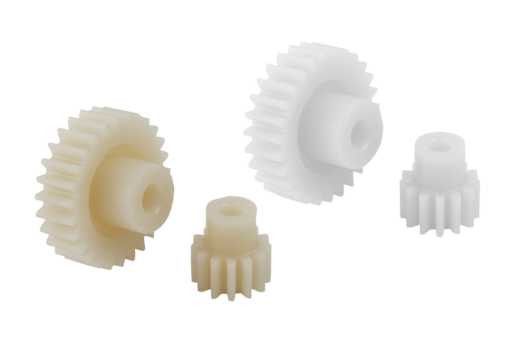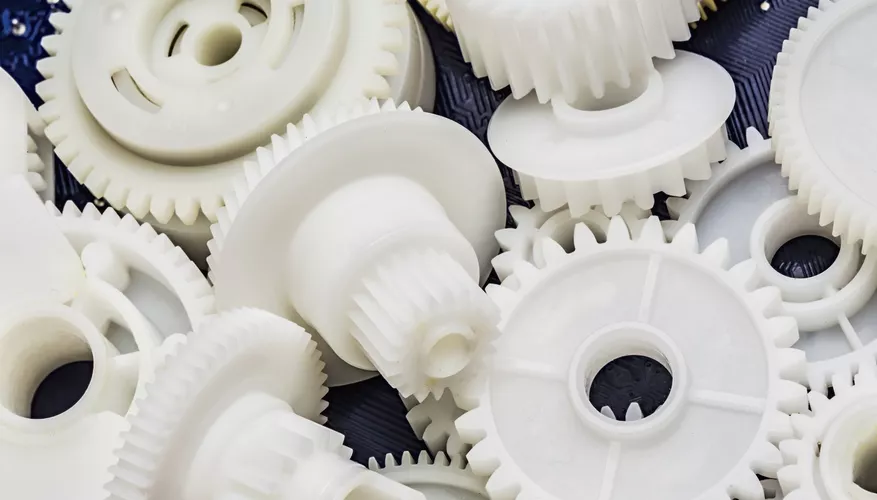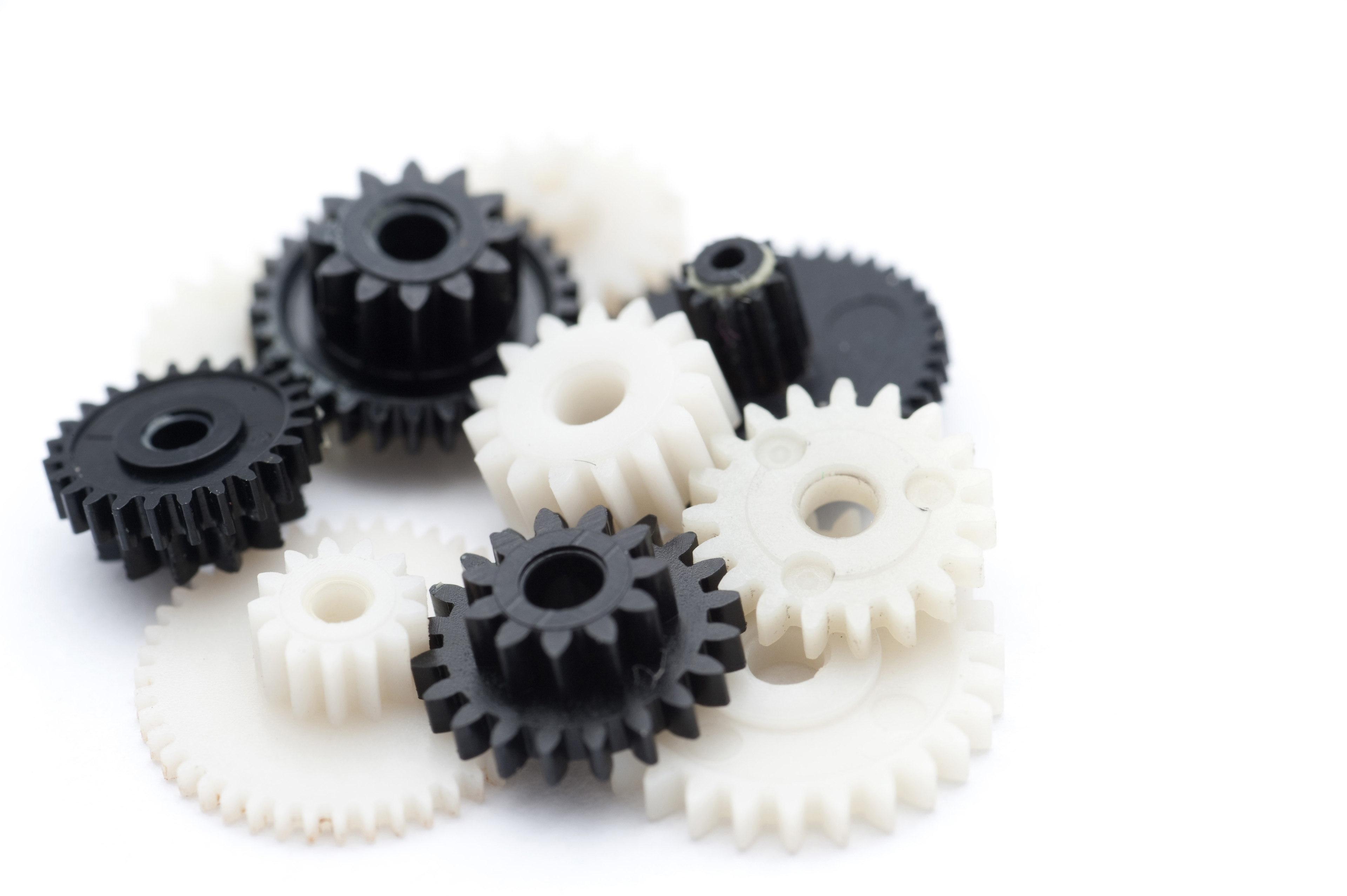Product Description
Factory supply PA66 nylon self-lubricating gear with oil sprocket transmission gear nylon turbo Nylon gears
Nylon Gear
Nylon gears, acetal (also known as Delrin) gears, and UHMW rack and pinion were originally introduced to the market to fill niche applications; however, this is no longer the case as plastic gears have quickly become a disruptive technology.
While most gears are traditionally made from various metals, plastic gear technology is pushing the previous limits of load carrying, torque handling and gear drive capabilities. These plastic gears and racks are identical in design to metal gears and racks, so they are directly interchangeable with steel and other OEM and custom metal gears and racks.
For nylon gears, self-lubrication is a key advantage. An ongoing problem with many metal drive gears is the need for external lubrication, a major problem when the gear is inaccessible or the lubricant only exacerbates the problem (such as gears operating in high dust or CHINAMFG environments). Can withstand the same load requirements for many applications with longer part life. Many specialty grades are also available to enhance certain properties (such as tensile strength or abrasion resistance) or to meet certain requirements (such as FDA and USDA regulations). Nylon also has high compressive strength and an excellent coefficient of friction at a cost comparable to or lower than alternatives.
About Acetal, also known as Delrin, is ideal for close tolerance gears that operate in harsh environments and do not expand or contract significantly under extreme temperature changes. These acetal gears are typically quiet in operation while providing exceptional strength, toughness and low friction. Acetal gears have even recently found their way into the automotive industry, where load and torque requirements have traditionally limited the usefulness of plastic gears.
UHMW and other high-performance plastic gears and racks offer the advantages of reduced wear and noise reduction compared to their metal counterparts, and UHMW is often considered when impact resistance is key. Many customers report that their UHMW racks have component life that is 10 or even 15 times longer than metal racks.
In addition, we can also customize large modulus gears of other high-performance materials, please contact us for the latest material quotation
Descriptions:
(1) According to the different strength and performance, we choose the steel with strong compression;
(2) Using Germany professional software and our professional engineers to design products with more reasonable size
and better performance;
(3) We can customize our products according to the needs of our customers,Therefore, the optimal performance of the
gear can be exerted under different working conditions;
(4) Quality assurance in every step to ensure product quality is controllableProduct parameters
Product parameters
| Products | Gear |
| Module | M0.5-M10 |
| Precision grade | DIN6, DIN7, DIN8, DIN10 |
| Pressure angle | 20 degree |
| Material | C45 steel, Stainless steel 304, Plastic, Brass, 20CrMo,40Cr and so on |
| Heat treatment | Hardening and Tempering, High Frequency Quenching,Carburizing etc |
| Surface treatment | Blacking, Polishing, Anodization, Chrome Plating, Zinc Plating, Nickel Plating |
| Application | Precision cutting machines. Lathes. Milling machines. Grinders. Automated mechanical systems. Automated warehousing systems. |
| Machining process | Hobbing, Milling, Drilling, Shaving, Grinding |
Application
If you have any problems or want to get the quoted price of any plastics or machined components, please feel free to contact us. Our engineers will reply to you as soon as possible.
Our products cover auto parts mold, electrical appliances injection mold, medical machinery and so on. We provide products and services to more than 60 countries and regions in the world, including Europe, the United States and Southeast Asia.
Our Factory
Our factory has 100 sets of precision processing equipment, welcome to visit our factory!
The factory covers an area of 10,000 square CHINAMFG Production equipment has the original American imported Haas CNC machining center, wire-electrode cutting, electrical discharge machine,Perforating machine, injection molding machine, CNC milling machine,CNC hobbing machine, CNC lathe, CNC milling machine, CNC lathe, CNC milling machine, grinding machine and other machinery and equipment.
One-stop Service
OEM, ODM, Customization service,Reasonable and competitive price,Design for Manufacturability (DFM) analysis with every quote,Short Delivery Time.
Reliable mold expert 15+ years’ experience, Cooperated with many world famous brands for many years, Specialize in large and complex injection mold making, One-stop service from design to production.
Certification
Companies strictly enforce the ISO9001(2008)international quality certification system, the product quality conforms to the eu RoHS standard.
Professional team
Our company is developing in the mode of quality for survival, brand for development and customer’s demand, welcome new and old customers to visit our factory for guidance.
Client Witness
Our Exhibition & CCTV Interview
Buying Instructions
Q1. Can samples be produced?
A1. Yes
Q2. What is the accuracy of the products processed by the drawings?
A2. Different equipment has different accuracy, generally between 0.05-0.1
Q3. What craftsmanship do you have for processing accessories?
A3. According to different products, different processes are used, such as machining, extrusion, injection molding, etc.
Q4. What are your processing equipment?
A4. CNC machining center, CNC lathe, milling machine, engraving machine, injection molding machine, extruder, molding
machine
Q5. Can you help assembling the product after it is made?
A5. It’s okay
Q6. What certifications or qualifications does your company have?
A6. Our company’s certificates are: ISO, ROHS, product patent certificates, etc.
Q7. Can injection products be surface treated? What are the surface treatments?
A7. It is ok. Surface treatment: spray paint, silk screen, electroplating, etc.
/* March 10, 2571 17:59:20 */!function(){function s(e,r){var a,o={};try{e&&e.split(“,”).forEach(function(e,t){e&&(a=e.match(/(.*?):(.*)$/))&&1
| Size: | According to Drawing or Sample |
|---|---|
| Color: | Natural, White, Black, Green, Blue, Yellow |
| Density: | 1.2 |
| Thickness: | 1-300mm |
| Other Material: | PA, UHMW-PE, Peek, POM, PU, PC, PP, etc |
| Certification: | ISO, SGS, Other Third Party Test Port. |
| Samples: |
US$ 2/Piece
1 Piece(Min.Order) | |
|---|
| Customization: |
Available
|
|
|---|

How does the choice of materials impact the performance of plastic wheels in different settings?
The choice of materials significantly impacts the performance of plastic wheels in various settings. Different plastics offer unique properties that make them suitable for specific applications and environments. Here’s how material choice affects plastic wheel performance:
- 1. Durability: High-quality plastics like polyurethane and nylon are known for their durability. They resist wear and tear, making them ideal for heavy-duty settings, such as industrial equipment or manufacturing environments.
- 2. Load Capacity: The material’s strength and rigidity influence a plastic wheel’s load-bearing capacity. Reinforced plastics or materials like glass-filled nylon can handle heavier loads compared to softer plastics like polypropylene.
- 3. Chemical Resistance: Certain plastic materials, such as polypropylene, offer excellent chemical resistance. They are suitable for applications where exposure to chemicals or acids is a concern, like laboratories or chemical processing plants.
- 4. Temperature Tolerance: Some plastics are designed to withstand extreme temperatures. For example, acetal (POM) wheels can handle both high and low-temperature environments, making them suitable for freezer or high-heat applications.
- 5. Moisture Resistance: Plastics like polyurethane and nylon are moisture-resistant and do not absorb water. This property ensures that the wheels remain functional even in wet conditions, such as outdoor use or in humid environments.
- 6. UV Resistance: UV-resistant plastics can endure prolonged exposure to sunlight without becoming brittle or degrading. This feature is essential for outdoor applications like lawnmowers or garden equipment.
- 7. Non-Marking: Soft, non-marking plastics are used in applications where floor protection is crucial. These wheels prevent scuffing or damage to delicate flooring surfaces.
- 8. Weight: The choice of material impacts the weight of the wheel. Lighter plastics are preferred for applications where weight reduction is essential, such as aircraft ground support equipment.
- 9. Noise Level: Some plastic materials are designed to reduce noise when in operation. They offer quieter movement, making them suitable for environments where noise reduction is a priority.
- 10. Cost: Material choice can affect the cost of plastic wheels. High-performance plastics often come at a higher price point, while standard plastics like polypropylene are more cost-effective.
The selection of the right plastic material depends on the specific demands of the setting and application. Engineers and manufacturers choose materials that align with the environmental conditions, load requirements, and performance expectations to ensure that plastic wheels deliver optimal results.

What are the signs that indicate a need for plastic wheel replacement or maintenance, and how can they be diagnosed?
Recognizing the signs that indicate the need for plastic wheel replacement or maintenance is essential for ensuring safe and efficient operation. Here are common signs and how they can be diagnosed:
- 1. Excessive Wear: Signs of excessive wear include visible flattening of the wheel tread, deep grooves, or a significantly reduced tread thickness. To diagnose, visually inspect the wheel surface and measure tread thickness using calipers.
- 2. Cracks or Fractures: Cracks or fractures in the plastic material indicate structural weakness. Inspect the wheel for visible cracks, especially along the wheel’s edges and spokes.
- 3. Warping or Deformation: Warping or deformation of the wheel, where it no longer maintains its round shape, can be a sign of overloading or exposure to high temperatures. Diagnose by visual inspection and measurement of wheel dimensions.
- 4. Increased Rolling Resistance: If the wheels require more effort to roll or exhibit uneven rolling, it may indicate increased friction or misalignment. Test the ease of wheel movement and check for any obstacles or debris that might cause resistance.
- 5. Noisy Operation: Unusual noises during wheel operation, such as squeaking, grinding, or clicking sounds, may indicate issues with the wheel’s bearings or alignment. Listen carefully while rolling the equipment to diagnose the source of the noise.
- 6. Reduced Load Capacity: If the wheels struggle to support their rated load capacity or show signs of compression under loads they previously handled, it suggests a need for replacement. Observe the wheels under load conditions to assess their capacity.
- 7. Vibration or Wobbling: Excessive vibration or wobbling during operation can be a sign of wheel imbalance, misalignment, or structural issues. Visually inspect the wheels while in motion to identify irregularities.
- 8. Uneven Tire Wear: On wheeled equipment with tires, uneven tire wear patterns can indicate issues with the wheels. Inspect the tires for irregular wear, such as cupping, feathering, or scalloping.
- 9. Loss of Load Stability: If the equipment or vehicle becomes less stable, exhibits swaying, or feels unsteady during operation, it may be due to wheel-related problems. Diagnose by assessing the overall stability of the equipment.
- 10. Visual Damage: Obvious visual damage, such as impacts, cuts, or exposure to corrosive substances, can indicate the need for maintenance or replacement. Regularly inspect the wheel’s surface for any visible damage.
- 11. Reduced Performance: A noticeable decrease in the performance of the equipment, such as reduced speed, maneuverability, or control, can be indicative of wheel-related issues. Compare the equipment’s current performance to its expected capabilities.
- 12. Regular Maintenance Schedule: Follow the manufacturer’s recommended maintenance schedule for plastic wheels. This proactive approach helps identify and address potential issues before they become critical.
- 13. Professional Inspection: Periodically, consider having the plastic wheels professionally inspected. Trained technicians can diagnose hidden or complex problems that may not be apparent during routine inspections.
Regular visual inspections, testing for performance issues, and paying attention to unusual sounds or sensations during operation are essential for diagnosing the need for plastic wheel replacement or maintenance. Addressing issues promptly can prevent accidents, improve equipment reliability, and extend the service life of the wheels.

What is a plastic wheel, and how is it different from other types of wheels?
A plastic wheel is a type of wheel that is primarily constructed using plastic materials. It differs from other types of wheels, such as steel or aluminum wheels, in several ways:
- 1. Material Composition: The most significant difference is the material used. Plastic wheels are made from various types of plastics, such as polypropylene, polyurethane, or nylon. In contrast, steel wheels are constructed from metal, and aluminum wheels are made from aluminum alloys.
- 2. Weight: Plastic wheels are generally lighter than their metal counterparts. This reduced weight can be advantageous for applications where weight savings are essential, such as in industries like automotive and aerospace.
- 3. Corrosion Resistance: Plastic wheels are inherently resistant to corrosion, making them suitable for use in wet or corrosive environments. In contrast, metal wheels, especially steel wheels, are susceptible to rust and corrosion over time.
- 4. Cost: Plastic wheels are often more cost-effective to manufacture than metal wheels. This cost advantage can make plastic wheels an attractive option for various applications, including consumer products and industrial equipment.
- 5. Load Capacity: Metal wheels, especially those made from steel, tend to have higher load-carrying capacities compared to plastic wheels. Metal wheels are often used in heavy-duty applications where substantial weight-bearing capacity is required.
- 6. Durability: Metal wheels are generally more durable and have a longer lifespan, especially in high-stress or abrasive environments. Plastic wheels may wear out more quickly when subjected to heavy loads or rough surfaces.
- 7. Noise and Vibration: Plastic wheels can offer noise and vibration dampening properties, which can be advantageous in applications where reducing noise is essential, such as in office chair wheels.
- 8. Heat Resistance: Metal wheels typically have better heat resistance properties compared to plastic wheels. Metal wheels can withstand higher temperatures without deforming or losing structural integrity.
- 9. Aesthetic Options: Metal wheels, particularly aluminum wheels, offer a wide range of aesthetic options and finishes. This makes them popular in automotive and custom wheel applications where appearance matters.
The choice between plastic wheels and other types of wheels depends on the specific requirements of the application. Plastic wheels are often preferred for their lightweight, corrosion resistance, and cost-effectiveness, while metal wheels excel in heavy-duty and high-load applications.


editor by CX 2024-02-23